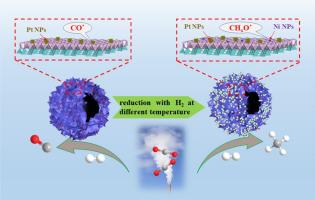Journal of CO2 Utilization ( IF 7.2 ) Pub Date : 2021-08-18 , DOI: 10.1016/j.jcou.2021.101674 Miaomiao Song 1 , Zhongliang Huang 1 , Bin Chen 1 , Sihan Liu 1 , Shafqat Ullah 1 , Dongren Cai 1 , Guowu Zhan 1

|
Catalyst design is one of the most critical factors in selectively converting CO2 and renewable H2 to value-added chemicals. In this work, Pt nanoparticles with an average size of 2.9 nm were uniformly loaded on hollow mesoporous nickel phyllosilicate which then underwent various reduction treatments to partial extraction of Ni atoms and formation of Ni-Pt bimetallic catalysts for the selective CO2 hydrogenation in a fixed bed reactor. Experimental results reveal that Pt nanoparticles supported on SiO2 are highly selective to CO via reversed water gas shift (RWGS) reaction with 100% CO selectivity, while Pt nanoparticles supported on nickel phyllosilicate show high selectivity for CH4, particularly, under high reduction temperature. By simply changing the reduction temperature or reaction pressure, the production selectivity can be facilely tuned, and the maximum CH4 selectivity achieved in the bimetallic Pt/Ni@phyllosilicate catalyst is 100%. The metallic Ni0 reduced from nickel phyllosilicate owns a high concentration of Lewis basic sites, which could enhance the adsorption strength of CO2 but prevent the dissociated adsorption. The diffuse reflectance infrared Fourier transform spectroscopy (DRIFTS) in different transient states were applied to study the mechanistic insights into how Ni-Pt dual sites tune the product selectivity. The results suggest that CO* over Pt site is the key species for CO2 conversion to CO, whereas the produced CO* could be further hydrogenated to CHxO* intermediate over Ni site, leading to the formation of CH4. The present work offers a new method to prepare Ni-Pt bimetallic catalysts with excellent CO2 hydrogenation performance towards CH4.
中文翻译:

层状硅酸镍负载 Pt 纳米催化剂的还原处理决定了 CO2 加氢中的产物选择性
催化剂设计是将 CO 2和可再生 H 2选择性转化为增值化学品的最关键因素之一。在这项工作中,平均尺寸为 2.9 nm 的 Pt 纳米粒子均匀负载在中空介孔页硅酸镍上,然后进行各种还原处理以部分提取 Ni 原子并形成 Ni-Pt 双金属催化剂,用于在固定条件下选择性加氢CO 2床反应器。实验结果表明,负载在 SiO 2上的 Pt 纳米粒子通过反向水煤气变换 (RWGS) 反应对 CO 具有高度选择性,CO 选择性为100%,而负载在页硅酸镍上的 Pt 纳米粒子对 CH 4显示出高选择性,特别是在高还原温度下。通过简单地改变还原温度或反应压力,可以轻松调节生产选择性,双金属 Pt/Ni@页硅酸盐催化剂中实现的最大 CH 4选择性为 100%。由页硅酸镍还原的金属Ni 0具有高浓度的路易斯碱位点,这可以增强CO 2的吸附强度但阻止离解吸附。应用不同瞬态下的漫反射红外傅里叶变换光谱 (DRIFTS) 来研究 Ni-Pt 双位点如何调节产品选择性的机制见解。结果表明 Pt 位点上的 CO* 是 CO 2的关键物种转化为 CO,而产生的 CO* 可以在 Ni 位点上进一步氢化为 CH x O* 中间体,从而形成 CH 4。目前的工作提供了一种制备对CH 4具有优异CO 2加氢性能的Ni-Pt双金属催化剂的新方法。











































 京公网安备 11010802027423号
京公网安备 11010802027423号